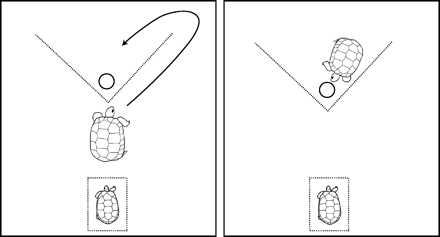In a previous post, AnimalWise saluted the red-footed tortoise (Geochelone carbonaria) for its Ig Nobel Prize achievements but, in doing so, may have unfairly maligned the tortoise’s cognitive capabilities. To atone for any past disparagement, this post is dedicated to an impressive, and perhaps surprising, red-footed tortoise intellectual accomplishment.
Many social animals are able to solve problems and shortcut the costly process of trial and error learning by simply observing the behavior of their peers. While some have speculated that this type of observational learning is an adaptation for social living that may be unique to animals who live together in groups, a research team led by Anna Wilkinson of the University of Vienna wanted to see whether a decidedly non-social animal, the red-footed tortoise, could also learn by observing others. Wilkinson specifically hoped to test the hypothesis that social learning abilities may simply be a reflection of an animal’s general learning capacity, and that non-social animals may be able to learn by observing peer behavior in fundamentally the same way as they use other environmental stimuli to learn.
The red-footed tortoises were perfect subjects for this study. The natives of Central and South American forests are naturally solitary, receiving no parental care (once the eggs hatch, it’s every little tortoise for himself and herself!) and, unless presented with a mating opportunity, living apart from other tortoises.
For Wilkinson’s study, eight young (juvenile or sub-adult) tortoises – four randomly assigned to the “non-observer” condition and the other four assigned to the “observer” condition – participated in a series of trials in which they needed to navigate around an obstacle to achieve a food reward. All trials took place in a square arena in which a 40 cm high V-shaped fence separated the tortoise from the desired food:
First, the tortoises in the non-observer groups were each given 12 trials (one per day) in which they were allowed two minutes to solve the task. Between trials, the bark flooring in the arena was redistributed to prevent the tortoises from being able to latch onto any scent trails from prior trials.
Next, the observer group tortoises had their turn. Their trials were identical except that, before each test, they were able to observe a specially-trained tortoise who invariably detoured around the right side of the obstacle and ate the food prize.
The results were unambiguous. While none of the non-observer tortoises ever solved the puzzle (they went up to the fence by the food, but never figured out how to go around the obstacle), all of the observer tortoises succeeded at least twice, with two of them correctly navigating around the barrier on the first attempt.
In other words, the red-footed tortoises have another addition for their trophy room. Not only are they the first red-footed and hard-shelled recipients of the Ig Nobel Prize, they are also the first non-social reptile to display social learning skills, revealing that group living is not necessarily a prerequisite for social learning.
_____
![]() Wilkinson, A., Kuenstner, K., Mueller, J., & Huber, L. (2010). Social learning in a non-social reptile (Geochelone carbonaria) Biology Letters, 6 (5), 614-616 DOI: 10.1098/rsbl.2010.0092.
Wilkinson, A., Kuenstner, K., Mueller, J., & Huber, L. (2010). Social learning in a non-social reptile (Geochelone carbonaria) Biology Letters, 6 (5), 614-616 DOI: 10.1098/rsbl.2010.0092.



Rosemary Lombard
/ February 22, 2012An observation from my years of exploring cognition in captive terrestrial turtles: Even if in the wild they are not social species (e.g., box turtles, Terrapene spp.), excluding agonistic and randy males, they can become social in captivity, in behavior not unlike the naturally close-living pancake tortoises (Malacochersus). Some associations can be attributed to all wanting to be in the best place, but individuals do form intra- and interspecies relationships: friends, if you will, or broken friendships.
paulfnorris
/ February 29, 2012Thanks for sharing your experiences, Rosemary – it sounds like your observations are quite consistent with these experimental findings, then. I would love to see more in the way of published cognitive research on “underrated” animals like turtles!